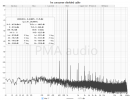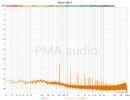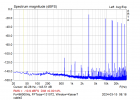- Thread Starter
- #61
-
Welcome to ASR. There are many reviews of audio hardware and expert members to help answer your questions. Click here to have your audio equipment measured for free!
You are using an out of date browser. It may not display this or other websites correctly.
You should upgrade or use an alternative browser.
You should upgrade or use an alternative browser.
Can you hear a difference between audio cables? ABX test
- Thread starter pma
- Start date
- Status
- Not open for further replies.
What is that ARTA spectrum?
I am totally convinced that the difference is inaudible with scientific control at 16 or more trials per test. Ambient noise is very low now, I limit the test to the noise in the beginning and maximize volume at 0 dBFS (with other settings the same as before). Hearing damage would ensue with music content.
Important to disable Windows sounds for this method.
Important to disable Windows sounds for this method.
- Thread Starter
- #64
The test (talking about single-ended cable) was done with a short, high quality coaxial cable. Far better than usual consumer audio cables. Its all about shield impedance in case of single ended cables and signal ground loops. Below the results for various single ended cables, starting with 50cm of high quality coaxial cable, to 2m of consumer audio cable. 1.5m consumer unshielded cable used as well. All compared to 10m of balanced Tasker C114 cable. S/N varies from 71.1dB to 105.1dB. Anyone, take your poison, in case you like single ended cables in the system with signal ground loops and you think it cannot make an audible difference.






If you still like the SE cables, my suggestion is to make a DIY cable based on RG-59 with good terminating connectors.






If you still like the SE cables, my suggestion is to make a DIY cable based on RG-59 with good terminating connectors.
DanielT
Master Contributor
You can say that again. A while ago I connected a active 2 way crossover. Everything in and out of that crossover via unbalanced RCA cables. My active crossover has only balanced XLR in and outputs so XLR-RCA adapters were used. High output from the crossover to an amp that powered up a pair of 108 dB sensitive compression drivers. Damn what a noise.That is fine and that is not the case. The case is that very different cables and/or interconnection method (single ended/balanced) may change the sound of the whole system depending on system configuration and components used, by introducing unwanted signals and noises. This is the merit of this test.
A completely wrong setup with various (they were also long) RCA cables plugged into an active crossover made for balanced inputs and outputs. Plus compression drivers with a damn high sensitivity. A recipe for disaster as it turned out to be.

Last edited:
- Thread Starter
- #67
OK. One more test file. The same setup as in the post #1, only that the RCA cable is now a conventional 1.5m consumer RCA cable that arrived with some cheap stuff. It is the one with 71.1dB S/N in post #64. I have recorded the same track as in post #1 and made a test file "cable3". You may find it in this link
 www.dropbox.com
www.dropbox.com
together with a Deltawave delta file with cable1 file. I have also made a requested ABX test and below is the 16/16 ABX record.
I do not think there may be any doubts that a poorly constructed SE cable may bring an audible difference. Oversimplification is always wrong.
The cable3 makes an audible difference compared to both cable1 (XLR) and cable2 (RCA short coax). Just for the reason of shield impedance and wrong (unshielded) construction.
The cable used in the cable3 file looks like this

Just the cable, right? No chance to guess without measurements.
Note: test files cable1 and cable2 (post #1) may be found on this link:
Dropbox
together with a Deltawave delta file with cable1 file. I have also made a requested ABX test and below is the 16/16 ABX record.
Code:
foo_abx 2.1 report
foobar2000 v2.0
2024-03-17 09:14:46
File A: cable1.wav
SHA1: 86fd0a74ab4a6a93d14521fce5e9ca3e0cf9022a
File B: cable3.wav
SHA1: ee244f1d3f32864da82e2742918ab494f20a1b22
Output:
WASAPI (shared) : Speakers (Cambridge Audio USB Audio 1.0)
Crossfading: NO
09:14:46 : Test started.
09:16:54 : 01/01
09:17:01 : 02/02
09:17:08 : 03/03
09:17:14 : 04/04
09:17:22 : 05/05
09:17:28 : 06/06
09:17:34 : 07/07
09:17:41 : 08/08
09:17:46 : 09/09
09:17:52 : 10/10
09:18:03 : 11/11
09:18:12 : 12/12
09:18:18 : 13/13
09:18:23 : 14/14
09:18:29 : 15/15
09:18:40 : 16/16
09:18:40 : Test finished.
----------
Total: 16/16
p-value: 0 (0%)
-- signature --
87042b895ba6e169e50fbadda6241639329719a6I do not think there may be any doubts that a poorly constructed SE cable may bring an audible difference. Oversimplification is always wrong.
The cable3 makes an audible difference compared to both cable1 (XLR) and cable2 (RCA short coax). Just for the reason of shield impedance and wrong (unshielded) construction.
The cable used in the cable3 file looks like this
Just the cable, right? No chance to guess without measurements.
Note: test files cable1 and cable2 (post #1) may be found on this link:
Last edited:
DanielT
Master Contributor
The cable used in the cable3 file looks like this
View attachment 356994
Just the cable, right? No chance to guess without measurements.
Note: test files cable1 and cable2 (post #1) may be found on this link:

Exactly like such crap RCA cables that I used for my testing in what I mentioned in #66 above.
It was doomed to fail.
I sliced up a fair amount of those cheapO RCA cables and found a few of them actually had thicker copper inside.Exactly like such crap RCA cables
I'm wondering if a line driver (for example this one https://www.abacus-electronics.de/produkte/linetreiber-variable.html) would improve the standard rca. According to the (science based) manufacturer, with that in place, the quality of the rca cable is irrelevant.
It's a nice little box for sure. The RCA cable voltage drop may be compensated for by increasing the source voltage @ the variable ABACUS line driver and yes that would negate the RCA voltage drop. The overall quality of the power transfer will not change though but it's such a short cable etc that it's really not a concern if the cable is basic decent quality or better.I'm wondering if a line driver (for example this one https://www.abacus-electronics.de/produkte/linetreiber-variable.html) would improve the standard rca. According to the (science based) manufacturer, with that in place, the quality of the rca cable is irrelevant.

JayGilb
Major Contributor
I personally cannot ignore certain members. While I frequently disagree with some posters, I believe that everyone has something to offer the conversation and need to rely on my bullshit detector to discern the truth. No better method can be found to sharpen my detector than to read and filter the wheat from the chaff.View attachment 356993In a way I admire your guys patience and politeness. It is probably helpful when someone new visits this thread and finds the right thing.
My solution was much simpler.
And I don't ignore some one lightly
I'm the same. Never ignored any peep and have no intention to do that either.I personally cannot ignore certain members. While I frequently disagree with some posters, I believe that everyone has something to offer the conversation and need to rely on my bullshit detector to discern the truth. No better method can be found to sharpen my detector than to read and filter the wheat from the chaff.
I don't know if people are advocating for SE, just what we might have. If I had this issue with USB ground loop I would look into a USB ground lifter rather than try to partially improve the situation with a better RCA. I haven't ever had the situation though, so I am speaking with a good deal of ignorance, maybe there is more to it than that.If you still like the SE cables, my suggestion is to make a DIY cable based on RG-59 with good terminating connectors.
- Thread Starter
- #76
System configuration and loop issues are the key. I do not care about any kind of manufacturer's hypothesis, I do only care about the results that can be measured, described and published. In case of the single-ended link transfer, the signal return impedance is the key and decisive parameter. Almost any reader here knows Ohm's law, at least I hope so. Error voltage on the signal return is Ve = Zs * Ig. Ve is the error voltage, Zs is the signal return (shield) impedance and Ig is the signal ground loop current. The error voltage Ve is added to the useful signal voltage. It may or may not be audible depending on Zs, Ig and music file used. There is nothing to speculate about, no hypothesis is necessary.I'm wondering if a line driver (for example this one https://www.abacus-electronics.de/produkte/linetreiber-variable.html) would improve the standard rca. According to the (science based) manufacturer, with that in place, the quality of the rca cable is irrelevant.
Last edited:
- Thread Starter
- #77
I can't hear any difference in cable3.wav
ABX is all about training. It is well known and published that the results of untrained and trained listeners do differ significantly. It is not about age, it is not about upper frequency limit of hearing. It is mostly about training and of course there should not be significant hearing loss.
In this test - find the part with low signal level, it is near 27.5 s. Turn volume quite low, not high. The cable3 file has buzzing background noise. Turn volume down when you still hear the background buzz from cable3 but no background buzz from cable1. It is absolutely reliable, as you can see from the 16/16 result. No cherry picking, just playing a while with volume control.
audio_tony
Addicted to Fun and Learning
I think the title of your thread is slightly misleading, and the thread should have been titled "Can you hear the difference between this signal with and without a ground loop"....It is my intention to emphasize the fact that balanced line is important.
You state that your intention is to emphasize that a balanced line is important, however whilst I agree that balanced connections have merit in some circumstances, there are other ways to avoid ground loops and still achieve similar or equal levels of (audible) performance.
DanielT
Master Contributor
But if you use RCA cables, you might as well buy good shielded ones with sensible contacts. Contacts which clamp in a good way, not too loose or too tight. Such RCA cables do not cost much money.I don't know if people are advocating for SE, just what we might have. If I had this issue with USB ground loop I would look into a USB ground lifter rather than try to partially improve the situation with a better RCA. I haven't ever had the situation though, so I am speaking with a good deal of ignorance, maybe there is more to it than that.
Plus, you shouldn't use unnecessarily long RCA cables (it's like asking for trouble), but everyone probably knows that.
Then there shouldn't be any problems with RCA cables.But okay, the opposite exists.My example in #66 is extreme where I add one bad thing to another, unnecessarily long (those were the ones I had at the time hence I used them),poorly shielded RCA cables in a stupid configuration.
Last edited:
Some people are trained not to hear a difference. They have been told and so believe all cables sound the same, in all situations. They are not trained to listen for noise in the chain or harmonic differences in sound. Our brain can easily ignore these cues. Others simply can't hear the difference due to the constant ringing/noise in their ears that they fight with each day. The definition of sound you hear may not be the same as your neighbor or your wife. I find it amazing in the rare case were everyone hears the same exact thing. It's quite rare except when the person is being told what they should hear before responding.
Last edited:
- Status
- Not open for further replies.
Similar threads
- Replies
- 94
- Views
- 10K
- Replies
- 60
- Views
- 5K
- Replies
- 89
- Views
- 7K
- Replies
- 59
- Views
- 4K
- Replies
- 20
- Views
- 2K







